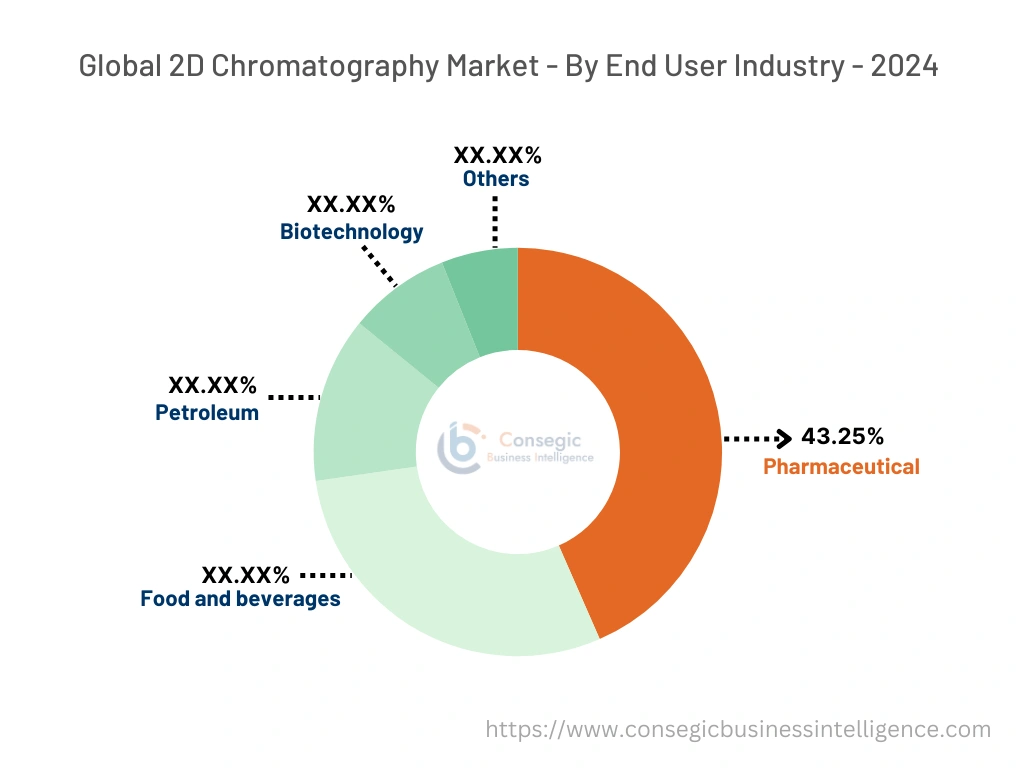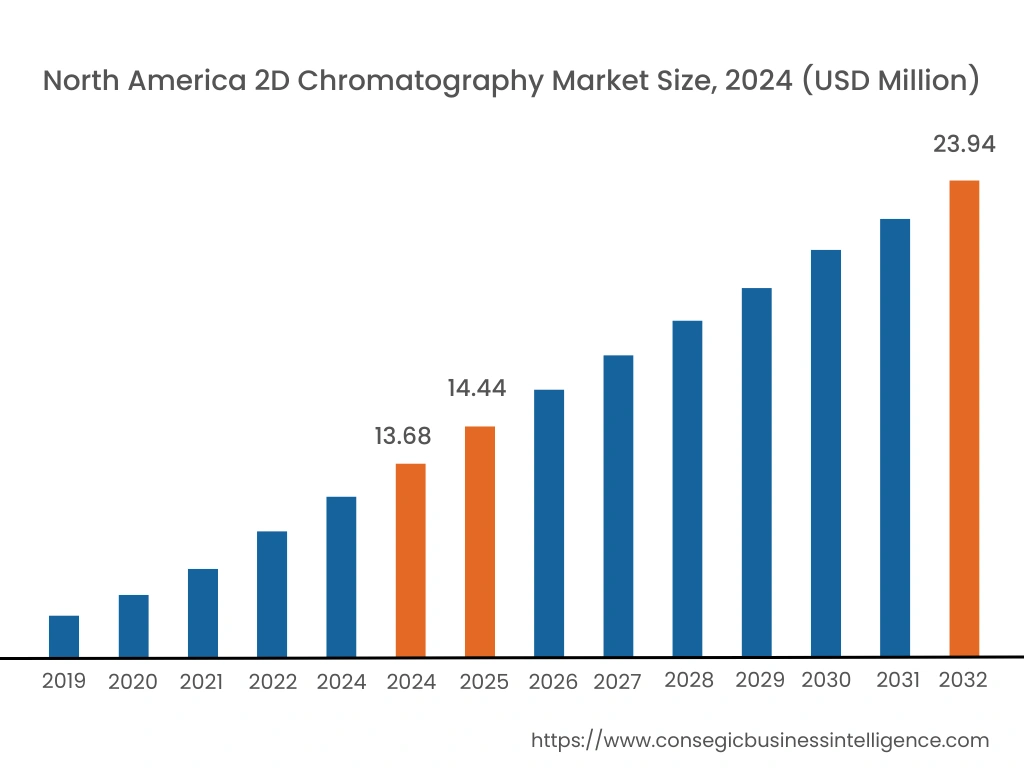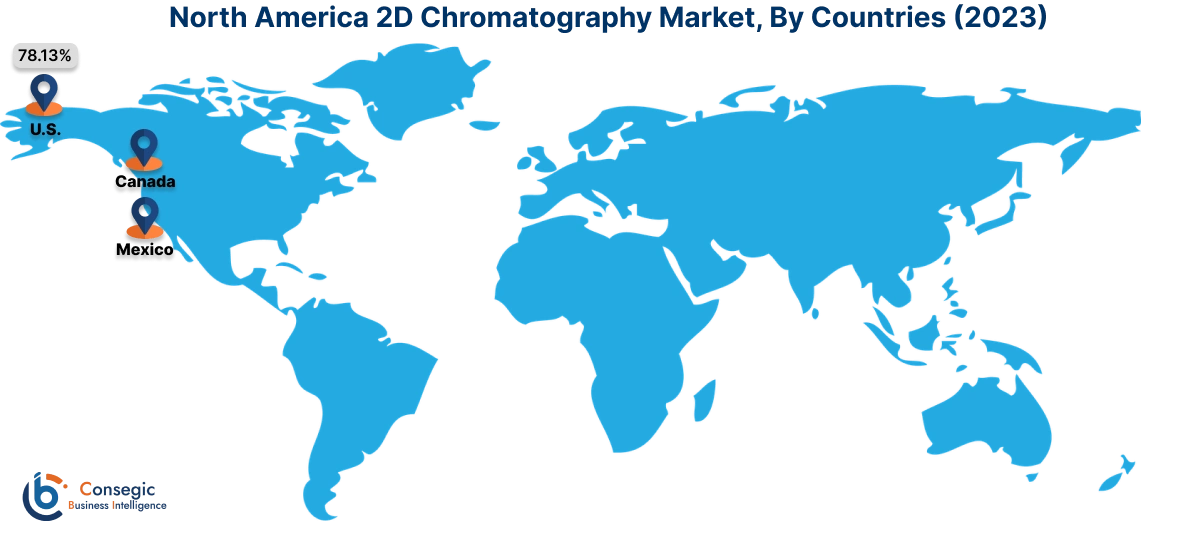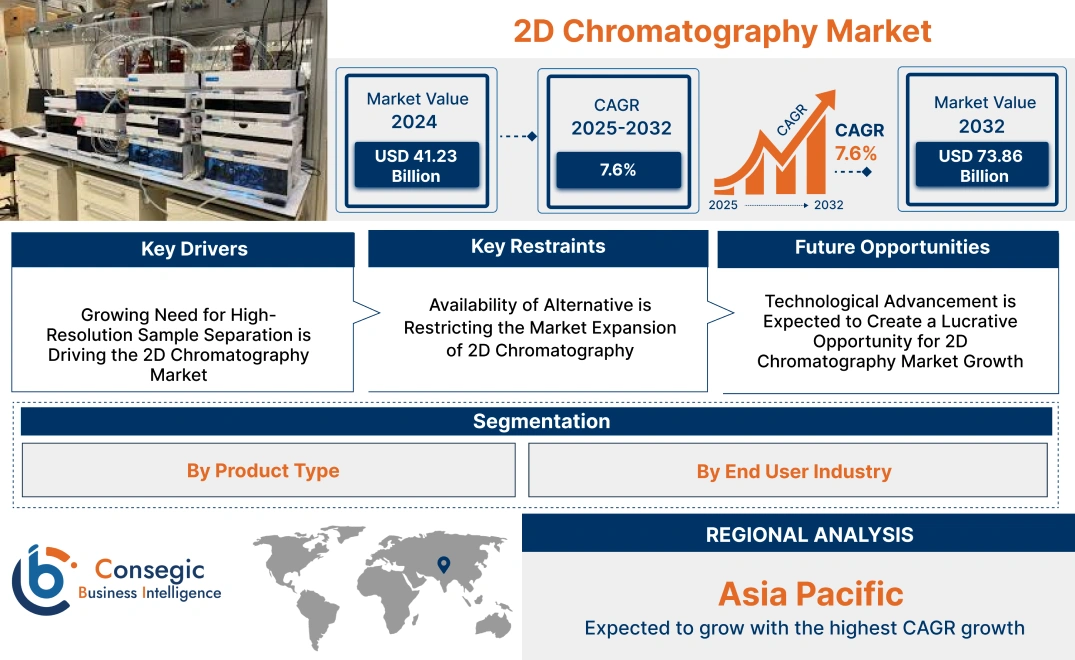2D Chromatography Market Size:
2D Chromatography Market size is estimated to reach over USD 73.86 Million by 2032 from a value of USD 41.23 Million in 2024 and is projected to grow by USD 43.61 Million in 2025, growing at a CAGR of 7.60% from 2025 to 2032.
2D Chromatography Market Scope & Overview:
2D Chromatography is the technique used for the separation, purification, and testing of compounds such as proteins, fatty acids, and pesticides, among others. In two-dimensional chromatography, the loaded sample is separated by passing through two different separation stages. It has two different separation columns connected in sequence. The effluent from the first column is transferred onto the second column. Two-dimensional chromatography is broadly classified into two types: 2D gas chromatography and 2D liquid chromatography. Gas chromatography uses gas which moves with the sample helping in separation, whereas liquid chromatography uses gas as a mobile phase. The development of 2D gas chromatography (GCxGC) and its commercialization compared to 2D liquid chromatography (LCxLC) is faster primarily due to the nature of the mobile phase, that is moreover applied in both dimensions. Currently, GCxGC and LCxLC methods are being developed for the non-targeted screening of environmental, food, and nutritional supplement samples. Furthermore, this technology is used in environmental studies, pharmaceuticals, metabolomics, forensic science, and product evaluation, among others. Additionally, it's used for determining purity, pollutant detection, drug identification, and more.
2D Chromatography Market Dynamics - (DRO) :

Key Drivers:
Growing Need for High-Resolution Sample Separation is Driving the 2D Chromatography Market
2D chromatography technology is a powerful tool used to decipher the compositions of various complex biological and pharmaceutical samples. Thus, in order to find the exact composition of complex samples, highly accurate sample separation is required. Globally, this accurate sample separation is achieved using 2D chromatography.
This technique is extensively being used in drug discovery and evaluation due to its high-resolution sample separation feature. It helps in understanding the disruption of metabolites in response to disease progression and drug treatment. Furthermore, 2D chromatography has emerged as a significant separation tool for high-resolution evaluation of disease-associated metabolites and pharmaceutically relevant molecules.
- In 2023 according to the National Center of Biotechnology Information, determination of the presence of aromatic amines in the urine of smokers and non-smokers using GC×GC–TOFMS, showed derivatization of aromatic amines to their corresponding aromatic iodine derivatives with enrichment on a polydimethylsiloxane/divinylbenzene fiber and gave an extraction efficiency of 65–85%.
Thus, as per the market trend, due to the high resolution of sample separation capability, the 2D chromatography market share is rising in demand.
Growing demand for 2D gas Chromatography in the Food and Beverage Industry
Gas chromatography is being widely applied for chemical profiling in food and beverage companies. Chemical profiling of food and beverages provides valuable insights into its potential effects on human health. Hops, a dried flower of hop plant, is an expensive ingredient in brewing. Hops secondary metabolites have a direct correlation with the quality of beer and other hop-based beverages. Thus, in order to improve the quality of beer, industries are using two-dimensional gas chromatography (GC×GC) for the identification and quantification of compounds present in hops.
Furthermore, GC×GC in the food and beverage sector when compared with conventional GC demonstrates enhanced separation capability, increased peak capacity, and increased sensitivity. The use of GC×GC–MS increases the number of peaks by over 300% compared to classical GC–MS.
- According to the National Institute of Standards and Technology, large amounts of data is generated using 2D gas chromatography (GCxGC) especially when coupled to mass spectrometry. Therefore, for research and development, in order to improve their product quality, food and beverage sector is adopting the use of 2D gas chromatography.
Thus, due to the increase in preference of in the food and beverage sector, the 2D gas chromatography market is growing in demand.
Key Restraints :
Availability of Alternative is Restricting the Market Expansion of 2D Chromatography
The presence of alternative analytical techniques such as capillary electrophoresis, nuclear magnetic resonance, isoelectric focusing (IEF), and more are limiting the market growth of 2D chromatography market expansion. The alternate analytical technique offers separation efficiency, similar to that of 2D chromatography. The presence of such an alternate option increases the competition for 2D chromatography industry. Furthermore, advancements in 1D chromatography such as ultra-high performance liquid chromatography has narrowed the gap with 2D chromatography. This type of advancement widens the choice of industries and limits the growth of the market.
Hence, the increasing number of industries adopting various alternatives, it is thereby limiting the adoption of 2D chromatography and limiting the market growth.
Future Opportunities :
Technological Advancement is Expected to Create a Lucrative Opportunity for 2D Chromatography Market Growth
Artificial Intelligence (AI) and machine learning (ML) have facilitated significant breakthroughs in drug discovery, the design of materials, organic synthesis, and more. AI in chromatographic prediction leads to faster and more accurate chromatographic analysis. 2D chromatography is a powerful analytical technique increasingly used in metabolomics research due to its enhanced separation capabilities, sensitivity, and resolution. AI and machine learning (ML) are increasingly becoming essential in separation science because of the large, multidimensional, high-resolution data generated in the 2D chromatographic process. This large data is not efficiently handled with 2D chromatography alone. Thus integration of AI into the development and optimization of this technique represents a significant technological advancement, offering enhanced capabilities, efficiency, and accuracy in the assessment of complex mixtures.
- In 2024 according to a study published at Trends in Analytical Chemistry (TrAC), AI techniques efficiently can explore the complex datasets derived from multidimensional platforms combining comprehensive two-dimensional chromatographic separations with mass spectrometry in the challenging application area of food-omics. Therefore, incorporating AI into 2D chromatography effectively will boost the analysis of complex data.
Thus, analysis of market trend shows that the incorporation of AI in this technique is expected to facilitate growing 2D chromatography market opportunity in upcoming years.
2D Chromatography Market Segmental Analysis :
By Product Type:
Based on product type the segment is categorized into 2D Liquid Chromatography and 2D Gas Chromatography
Trends in the Product Type:
- The 2D Gas Chromatography is majorly preferred due to its unparalleled separation power.
The 2D Gas Chromatography accounted for the largest revenue of the total Market share in the year 2024.
- Globally, 2D chromatography is increasingly being used across various industries.
- It is a highly specialized tool opted by researchers due to its high resolution separation.
- Further as the technology and software have been improved, the user experience has become more streamlined and the applications have expanded.
- 2D Gas Chromatography is increasingly being used for many routine applications such as petroleum, food and beverage fragrance profiling, biomarker discovery, and environmental monitoring, among others.
- In 2023 according to the National Center of Biotechnology Information, comprehensive two-dimensional gas chromatography (GC×GC) globally has emerged as a significant separation tool for high-resolution evaluation.
- Thus, due to the high resolving separation, globally this technique is used in the analysis of disease-associated metabolites and pharmaceutically important compounds.
2D Liquid Chromatography segment is anticipated to register the fastest CAGR during the forecast period.
- Two-dimensional liquid chromatography (2D-LC) is becoming more widely adopted across a variety of industries to solve difficult separation problems.
- This technique dominates all other liquid chromatography techniques.
- In 2D-LC, two different separation modes are exploited to increase the maximum peak capacity and achieve optimal separation efficiency.
- Furthermore, increased availability and developments in commercially available 2D-LC are lowering the barrier to its wider use.
- In 2023 according to the National Center of Biotechnology Information, globally, the heart-cutting mode of 2D-LC, is providing targeted assessment in a complex material such as proteins in blood serum.
- Additionally, due to the chief advantage of 2D-LC in its ability to increase its peak capacity without increasing the overall assessment time, its adoption rate is growing at a higher rate.
- Thus, as per the analysis of segmental trends, Liquid 2D Chromatography market is expected to rise.
By End-User Industry:
Based on end-user the market is segmented into pharmaceutical, food and beverages, biotechnology, petroleum, research, and others
Trends in the End User Industry:
- Pharmaceutical and Biotechnology segment dominates the use of 2D liquid Chromatography due to its effectiveness in drug discovery.
The pharmaceutical segment accounted for the largest revenue share of 43.25% in the year 2024.
- Globally, two-dimensional liquid chromatography (2D-LC) is the most widely used technique in the pharmaceutical laboratory for the separation of complex samples.
- Additionally, comprehensive 2D-LC and heart-cutting 2D-LC sub types of 2D-LC are highly preferred techniques.
- Furthermore, to enhance the resolution, developments have been made to heart-cutting 2D-LC called multiple heart-cutting 2D-LC, and it is increasingly becoming a popular technique in drug development at pharmaceutical companies.
- The multiple heart-cutting 2D-LC is preferred majorly for impurity assessment of pharmaceutical substances and fine chemicals.
- In 2023 according to the National Center of Biotechnology Information, globally 2D-LC is widely used in majority of the pharmaceutical companies, due to its increased maximum peak capacity and achieve optimal separation efficiency.
- Thus, analysis of segmental trend concludes that the application of 2D chromatography in pharmaceuticals is dominating the 2D chromatography market.
The food and beverage segment is anticipated to register the fastest CAGR during the forecast period.
- The adoption rate of 2D Chromatography in the food and beverage sector is growing due to its ability to analyze the constituents of food and food-related samples.
- This technique is crucial for food quality identification.
- It provides valuable information not only on the components present in food products, but also physicochemical properties, sensory attributes, and eventual presence of contaminants in food product.
- Additionally, the determination of the bioactive content using this technique in food and food-based products is gaining considerable attention.
- In 2023 according to a study published in Current Opinion in Food Science journal, globally, due to increased separation and resolving power, 2D liquid chromatography (2D-LC) is increasingly used for assessment of valuable complex food samples in the field of food authentication.
- Thus, the segmental trend of 2D Chromatography Market analysis shows that the food and beverage segment is a fast-growing market.

Regional Analysis:
The regions covered are North America, Europe, Asia Pacific, the Middle East and Africa, and Latin America.

In 2024, North America accounted for the highest market share at 38.15% and was valued at USD 13.68 Million, and is expected to reach USD 23.94 Million in 2032. In North America, the U.S. accounted for the highest market share of 78.13% during the base year of 2024. Drug discovery and development is continuously increasing demand in North America in order to appropriately treat diseases or clinical conditions. In the United States two-dimensional chromatography is emerging as a significant separation tool for high-resolution assessment of disease-associated metabolites and pharmaceutically relevant molecules. The application of 2D gas chromatography (GC×GC) in drug discovery is helping pharmaceuticals in the region. Further, it helps in understanding the disruption of metabolites in response to disease progression or drug treatment.
Furthermore, the implementation of GC×GC in drug discovery is expected to continuously grow in North America and help in the development of personalized disease diagnosis, patient monitoring, and treatment response evaluation. Additionally, in United Stated rising number of pharmaceutical and biotechnology companies are discovering and developing new drugs with the help of 2D chromatography.
- According to the Food and Drug Administration, 25 of the 37 novel drugs approved in 2022 (68%) were first approved in the U.S. These approvals demonstrate the efficiencies of the use of 2D chromatography in research and development phase of drug discovery. This shows that there is increased use of 2D chromatography in the United States.
Thus, due to increasing drug discovery and the importance of 2D chromatography in drug discovery, the 2D chromatography market trend is rising in North America.

Asia Pacific is expected to witness the fastest CAGR over the forecast period of 8.0% during 2025-2032. In Asia Pacific biotechnology industry growth is fueled by development in bio-pharmaceutical, bio-industrial, bio-services, bio-agricultural, bioinformatics, and more. 2D chromatography, plays a crucial role in bioinformatics research, particularly in proteomics, metabolomics, and more. In China, the use 2D chromatography is growing in bioinformatics research. This technology is helping scientists in the Asia Pacific region to separate, analyze and characterize the biomolecule and further determine the protein structure and detect changes in the metabolic pathway. The data obtained from the research are further stored in the bioinformatics database. Furthermore, the infrastructure of the China National Center for Bio-information is observed to develop at an increased pace.
- In 2023 according to the National Center of Biotechnology Information, the National Genomics Data Center (NGDC) and China National Center for Bio-information (CNCB) is frequently upgrading infrastructure capabilities, with 1.6 gigabits per second (Gbps) of network bandwidth, 8300 computing cores, 266 teraflops (TFLOPs) of computing resources, and nearly 39 petabytes (PB) of storage. This upgrade signifies that an increased amount of data is being generated by the separation, analysis, and characterization of biomolecules and proteins, further demonstrating the increased adoption rate of 2D Chromatography at NGDC and CNCB.
Thus, as the biotechnology industry is growing in the Asia Pacific region, the 2D chromatography market is expected to rise exponentially.
In Europe, 2D chromatography is widely being used in food and beverage industries. There is growing demand for 2D-LC–MS (2D liquid chromatography-mass spectroscopy) in Germany, the Unite Kingdom, and France due to its increased use in the evaluation of pesticide residue of food products and beverages. The resolving power of 2D-LC–MS facilitates the in-depth characterization of vitamins, proteins, preservatives, additives, fats, and more. Additionally, Europe is also emphasizing more on environment monitoring, where 2D chromatography plays a vital role in analyzing environmental pollution. Thus, the evaluation of regional trend shows that the 2D chromatography market demand is rising.
The use of 2D chromatography is slowing rising in Latin America. In countries such as Brazil, Argentina and Mexico, 2D chromatographic techniques is trying to be used in the evaluation of persistent organic pollutants in environmental samples. Evaluation of complex samples in environmental matrices poses an extreme challenge for analytical chemists as the number of known and unknown compounds are numerous and have varying physical and chemical properties. Thus, comprehensive two-dimensional (2D) gas chromatography (GC × GC) paired with mass spectrometry (MS) in Latin America is helping environmentalists to determine analytical profiles of ultra-trace levels of organic pollutants from different environmental samples. This shows that there is a lucrative opportunity for 2D chromatography market growth in Latin America.
More than half of the world's proven oil reserves are located in the Middle East and African region. Mineral oil hydrocarbons contain a wide structural diversity of molecules, therefore in countries such as United Arab Emirates, Saudi Arabia, Dubai and more, coupled liquid chromatography-gas chromatography with flame ionization detection (LC-GC-FID) is used for the evaluation of mineral oil hydrocarbons. Additionally, 2-dimensional gas chromatography (GCXGC) measures the hydrocarbon composition of intermediate distillates. Products such as diesel fuels (mineral diesel, light gas oil (LGO), medium gas oil (MGO), heavy gas oil (HGO), diesel fatty acid methyl ester (FAME) blends), kerosene, synthetic diesel fuels (GTL, BTL, CTL, HVO) and more are tested using 2D chromatography technique in Middle East region. Thus, due to the extensive use of this technique in oil industry, the market is subjected for substantial growth in the Middle East and African region.
Top Key Players & Market Share Insights:
The 2D Chromatography Market is highly competitive with major players providing products and services to the national and international markets. Key players are adopting several strategies in research and development (R&D), product innovation, and end-user launches to hold a strong position in the Global 2D Chromatography Market. Key players in the 2D Chromatography Market include-
- Thermo Fisher Scientific Inc. (United States)
- Shimadzu Corporation (Japan)
- LECO Corporation (United States)
- Agilent (United States)
- Waters Corporation (United States)
- BUCHI India Pvt Ltd (India)
Recent Industry Developments :
Product launch:
- In 2021, Thermo Scientific launched, Vanquish Online 2D-Liquid Chromatography Systems, which offered a robust and flexible platform for pharmaceutical/biopharmaceutical R&D, food safety, environmental testing, omics and polymer assessment scientists to characterize complex samples in-depth with the highest confidence.
Partnership:
- In 2020, Waters partnered with Polymer Standards Service (PSS) to bring a robust comprehensive 2D chromatography solution to the market. Their innovative solution enhanced the speed and solvent compatible capabilities of the APC system and leveraged the benefits of PSS software. It is a partnership that extends the prospects for the full characterization of the most complex polymers and additives with multi-dimensional distributions.
2D Chromatography Market Report Insights :
| Report Attributes | Report Details |
| Study Timeline | 2019-2032 |
| Market Size in 2032 | USD 73.86 Million |
| CAGR (2025-2032) | 7.6% |
| By Product Type |
|
| By End Use Industry |
|
| By Region |
|
| Key Players |
|
| North America | U.S. Canada Mexico |
| Europe | U.K. Germany France Spain Italy Russia Benelux Rest of Europe |
| APAC | China South Korea Japan India Australia ASEAN Rest of Asia-Pacific |
| Middle East and Africa | GCC Turkey South Africa Rest of MEA |
| LATAM | Brazil Argentina Chile Rest of LATAM |
| Report Coverage |
|
Key Questions Answered in the Report
How big is the 2D Chromatography Market? +
2D Chromatography Market size is estimated to reach over USD 73.86 Million by 2032 from a value of USD 41.23 Million in 2024 and is projected to grow by USD 43.61 Million in 2025, growing at a CAGR of 7.60% from 2025 to 2032.
Which is the fastest-growing region in the 2D Chromatography Market? +
The fastest-growing region in the 2D Chromatography Market is Asia Pacific.
What specific segmentation details are covered in the 2D Chromatography Market report? +
The specific segments that are covered in the 2D Chromatography Market are product type and end-user.
Who are the major players in the 2D Chromatography Market? +
The major players in the 2D Chromatography Market are Thermo Fisher Scientific Inc. (United States), Shimadzu Corporation (Japan), Agilent (United States), Waters Corporation (United States), BUCHI India Pvt Ltd (India), LECO Corporation (United States).

